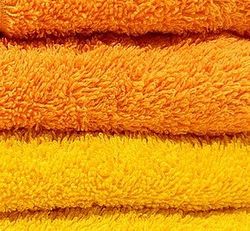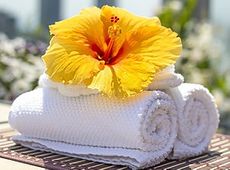There was no looking back after I figured how to clean with microfiber. It gets rid of dust effectively and quite effortlessly, creating a dust free home for my eczema warriors who have dust mite allergy. Using microfiber also paves the way to green and natural cleaning, as I can now do away with chemical-laden cleaning products.

What is microfiber
Microfiber is made of synthetic materials, more specifically nylon and polyester. The raw materials go through tiny tubes to be made into fibers, which are then further split apart to obtain much smaller fibers, in the range of 0.3 micrometers (the best microfiber cloths) to 4 micrometers (for an average microfiber cloth) in diameter.
Due to their small size, the best microfibers can pick up over 99 percent of bacteria and some viruses (definitely not all). This is because in the microscopic world, strong forces called Van der Waals exist between the microfibers and the particles that they come in contact with.
This strong attraction force ‘sucks’ up all the dirt and dust from surfaces. This is something we do not come across in the scale of things that we encounter everyday, so it may seem like magic, but it is actually molecular science. There is more technical information about microfiber on this website: washington.edu
This linked study has found microfiber cloths useful in reducing the spread of infections in hospital environments. Another study (click this link) focused on transfer of viruses back to food contact surfaces after various types of cloths were used to clean a contaminated area. Microfiber was found to retain the viruses it cleaned, and transferred the least back onto surfaces.
Advantages of cleaning with microfiber
Green cleaning, chemical free – We really do not need to dump detergents or chemicals onto the floors, windows and tabletops at home in order to clean effectively. Not even a single drop. Plain water will do when we use microfiber cloths. For stubborn greases, I spray some vinegar water (in 50:50 ratio), or use diluted Dr Bronner’s castile soap (made from organic plant oils), depending on the type of surface. After that, just wipe off with microfiber cloth.
Removes dust effectively – this is so important for my eczema warriors, who had been tested allergic to dust mites. Keeping a dust free home is the minimum I can do to keep one of their main triggers at bay. A microfiber cloth is the one for this job, as regular cloths simply spread the dust around or agitate it into the air.
Removes 99% of bacteria – if you get a high quality microfiber cloth, this is what it can do. It will protect your family from common bacterial infections by minimising its spread. Wipe playing areas frequently with microfiber cloths when you have a sneezing or coughing toddler, and you will be modeling after some hygiene standards of hospitals!
You may be asking, if the microfiber cloth is really that good, why is it not used more extensively by everyone around the world? The answer goes right back to the giant manufacturers of commercial cleaning products, who spend fortunes on advertising and brainwashing people with the mindset that only their heavily researched products with the right chemicals will give you a safe and sparkling clean home. So, go figure.
How to clean with microfiber
Here are some practical tips on how to clean with microfiber, to get the best cleaning results.

Clean with sections of the microfiber cloth – I fold my microfiber cloth into half, and half again. This allows me to maximise the efficient use of the cloth’s area, so that I don’t send it into the washing pail with large areas unused or just lightly used.
Use it dry, or just very slightly damp. I like to fill a spray bottle with water or other natural cleaning agent (vinegar water, or diluted Castile soap), spray it onto the surface, and wipe with microfiber cloth.
Technique is important when it comes to using a microfiber cloth. Wipe in one direction, so that the dust that has accumulated on the cloth stays intact. Reversing the direction can loosen small clumps of dirt, releasing them back onto the surface. Also, lift off the cloth only at the edge of the surface, wherever possible, so that it is a follow-through motion that has no abrupt stop on the surface, otherwise it can again dislodge particles that have clumped together.
Top down, work from higher surfaces to lower ones – wipe the top shelf first, followed by the layers below, and the floor the last. So that any dust clumps that have fallen off the cloth will be noticed as you wipe the lower surfaces, and can finally be removed as you work on the floor.
If the surface is very dirty, work off most of the dirt first, by rinsing or hosing with water, or with the help of a damp rag or kitchen towel. Let the surface come to an almost complete dry, then wipe with microfiber cloth, making use of the last drops of water to slightly dampen it. This way, it will be cleaned to the highest standard of no dust and almost no bacteria, while preserving the microfiber cloth’s lifespan to work on the micro-particles, instead of working it to its premature death to clean the gigantic balls of dust.
Washing your microfiber cloth
After each use, I wash my microfiber cloth in a small pail of plain water by lightly agitating it to flush out the dirt. Being soaked in water tends to loosen the dirt better than simply running it under the tap. If the water becomes very dirty, pour it away and refill with clean water for another round of flushing. That’s it, nothing else needed, just plain water. After that, wring out the water, and hang it out to dry, and it’s ready for the next use.
I will carry out deep cleaning of the microfiber cloths when they get tired, or when they start to smell. Put the cloth in a small pot of boiling water with 1 to 2 tablespoons of baking soda, and let it boil for about 10 minutes.

Washing and maintenance of the microfiber cloth are as simple as the cloth is.
Clean your way to a green home
I hope I have persuaded you to dump the commercial cleaning products, and provided you with sufficient details on how to clean with microfiber. Go ahead, take the first step towards a cleaner and greener home. Once you do it, you won’t look back, because it will become obvious why this is the way to go.

What a lovely site- very fresh and engaging article
Thank you
Hi Vicki, I’m glad you like it. Thank you for dropping by.
Thank you for sharing the wonders of microfiber cloth. Ready enjoyed the read. Very informative.
Jennifer
Hi Jennifer, great that you found the information helpful.
Wow who knew there would be this many benefits to microfiber cloths! Glad I got the chance to read this. Thanks for the awesome article.
Hi Brandon,
Yes microfiber cloths are the life saver! My eczema kids now get to stay in a green and natural home. Do give it a try if there is a chance.
Very informative article, thanks! We really need to use as little chemicals as possible in our homes, and this is a good way to do it.
Hi Mariette,
Yes, chemical free is the way to go. Thank you for reading.
Great information! Really detailed and thorough. I love microfiber towels to clean with. They really do pick up so much more!
Hi Shyla,
I’m happy for you that you have found the benefits of cleaning with microfiber towels! They’re really one of the best inventions!
Hi There,
Cleaning with microfiber is always effective for me. As far as I know, it can be used mostly when cleaning special surfaces such as glass and in general tender surface which can easily be damaged.
You explain it very well and you bring some really interesting insights.
Hi Asen,
Glad that you’re already reaping the benefits of cleaning with microfiber cloths! Yes, they’re great on glass and any delicate surface, as the strands are so soft and non-abrasive too.